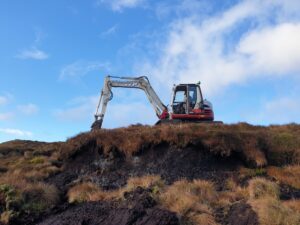
Peatland activity to be significantly expanded to help National Park become a ‘carbon sink’ for Scotland
The pace and scale of peatland restoration across Loch Lomond & The Trossachs National Park is set to increase significantly to reduce carbon emissions and tackle climate change.
The National Park Authority has set a target of repairing 8000ha of peatlands by 2030 and plans to accelerate the rate of restoration from an average of 240ha per year to 640ha per year.
This represents a significant increase on the 1147ha of damaged peatland restored across the National Park between 2018-2023.
Around 36% (68,000ha) of land in the National Park is covered by peatlands, holding an estimated 20 million tonnes of carbon.
Healthy peatlands absorb carbon and other greenhouse gases from the atmosphere but with much of Scotland’s peatlands damaged by historical agricultural, forestry and other land management practices, they are currently emitting carbon and contributing to climate change.
Peatland restoration helps turn a peatland that is emitting carbon and other greenhouse gases into one which locks them up and over time, absorbs them from the atmosphere.
As part of the national Peatland Action programme, Loch Lomond & The Trossachs National Park Authority works with local land managers to restore the Park’s peatlands, improving the condition of uplands traditionally used for livestock and deer grazing.
Tackling climate change and biodiversity loss are set out as ‘non-negotiables’ in the Draft National Park Partnership Plan published by Loch Lomond & The Trossachs National Park Authority last month, on which it is now seeking views from everyone with an interest in the National Park.
Simon Jones, Director of Environment at Loch Lomond & The Trossachs National Park Authority, said
“The natural environment could be our greatest ally in tackling the climate emergency with our peatlands and woodlands capable of capturing and storing significant amounts of carbon.
“Restoring our peatlands to favourable condition is absolutely essential. Degraded peatland is an active CO2 emitter and a major source of carbon emissions in Scotland.
“By working with public and private land managers in the National Park, we are scaling up work to restore our peatlands, remove invasive non-native species and reduce herbivore pressures from animals like deer and sheep, ensuring the National Park can become a major carbon sink for Scotland.
“We are already restoring more of our peatlands than ever before and our Draft National Park Partnership Plan sets out our ambitions to do even more. As part of our ongoing conversation about the future of the National Park we want to hear people’s views on how we tackle the climate and nature crises and ensure a sustainable future for the people and places within the Park.”
After transport emissions, degraded peatland is Scotland’s greatest source of greenhouse gas emissions. In 2020, the Scottish Government announced a £250 million ten-year funding package to support peatland restoration, with a target of restoring 250,000 ha of degraded peatland by 2030.
As well as capturing and storing carbon, healthy peat forms a unique and biodiverse ecosystem and can help slow the flow of water into rivers and lochs, providing natural flood management and reducing the impact of extreme weather events on communities.
As Scotland transitions to a greener economy, NatureScot calculates that the peatland restoration sector will require an additional 1500 skilled people by 2025 to meet Scotland’s ambitious climate targets.
Case study: DC Restoration Contracts Ltd

Daniel Carnegie, from Comrie in Perthshire, runs his own peatland restoration business and has recently invested in more staff and equipment to meet demand. The 24-year-old started working as a self-employed contractor in peatland restoration in 2021 and has had a steady stream of work ever since. He soon needed help and now employs two other staff, with plans to bring in more in time for the peatland season getting underway again in August.
He said: “There’s massive satisfaction in this type of work. We call it ‘tidying up the hill’, where you start off looking at a hill that’s black, with bare bits everywhere, and by the time you’ve finished, the hags have gone and it’s green. And you know you’re doing something important too, helping with climate change.
“It was just me when I started out but there’s three of us now and I might need to start a fourth boy this year. Peatland work needs to be ramped up, it needs to happen faster and organisations know that so the work is definitely there and I’ve just invested in a third digger to make sure we can respond to that.
“I’ve previously done other work on farms and driving but my whole business is based around peatland restoration now and I don’t see that changing any time soon.”
Anyone with an interest in Loch Lomond & The Trossachs National Park can share their views and ideas on its future (before 19th July 2023) at www.lochlomond-trossachs.org/future

